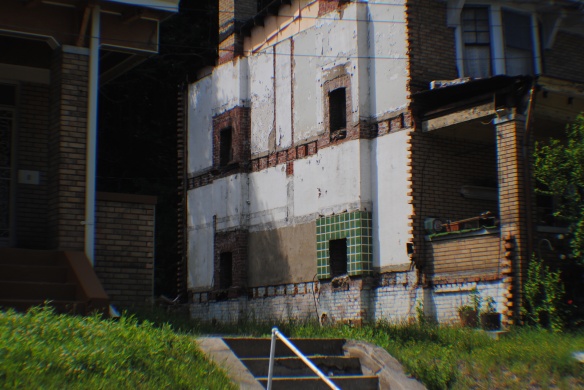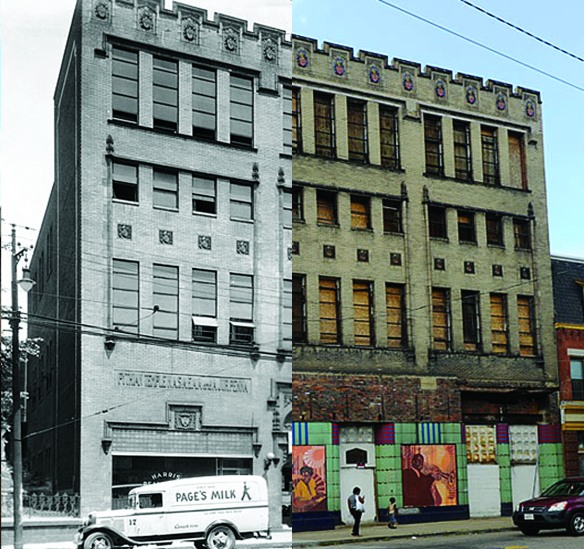Updates from curators Gavin White and Monika Ponjavić. Be sure to check out our Call for Artists, open until Aug. 10, if you’re an artist who’d like to work with Mo and Gavin or any of the curator teams!
Upon applying to be a curator of this project we were asked to question revitalization. It is a task we have been revisiting ever since. And I still fixate on the reiteration implicit in the term. It is the Re in revitalization, I think, that makes it so problematic. To revitalize something is to bring it back to life. In some cases, this can be a marvelous, even miraculous thing, but it has a darker side too—just think zombies, or Frankenstein. Meddling with life, of a body or a city, can be dangerous.
In the name of revitalization, indeed during Pittsburgh’s so-called “Renaissance” of the 50’s, the Hill District was disconnected from downtown by the Civic Arena and adjacent highways, and from the Strip District through the demolition of an incline. Today Pittsburgh is frequently touted for its remarkable ability to revitalize but the Hill, at the city’s center, still struggles and remains isolated. Because of these challenges the Hill puts to revitalization, and because I happen to be a resident of the Hill, I chose to center our performance in this neighborhood that poet Claude McKay called the “crossroads of the world,” given its importance as a stop for Jazz artists between Chicago and New York. By bringing international and local artists together in our own project, we recall this time in the neighborhood’s history, and hope to celebrate the connection it implies.
We also need to look to the future, and to the actors forging paths to get there. The master plan for redeveloping the Hill, cleverly called the “Greenprint,” paints a picture of “a village in the woods.” It seeks to take advantage of the district’s abundant greenery (in part a product of large scale vacancy and demolition) and magnificent vistas of the city. It is, superficially, a more isolated picture than that of the “crossroads,” but its attempt to connect to its surrounding ecology, natural and built, is admirable. Nor are the two images mutually exclusive. Who doesn’t want to live in a village in the woods on a hill in the city at the crossroads of the world? And vitality is all about living.

From Gavin: “This photo is not of a particular space I have in mind; I just love these remaining fireplaces that occur throughout the seat in instances of demolition”
To bring something back to life you have to at least restart its heart (otherwise it is simply undead). And so we intend to explore the Hill, the heart of Pittsburgh, in the hopes of learning how one might revitalize the city as a whole.
—Gavin White
All of this leads Gavin and Monika, as co-curators, to this central question for their project:
Can we alter space without re-placing it?
Whether we are prompted by present deterioration or imaginings of a better past, to revitalize is to revisit, to restore, to return. A Second Steel.
And while Pittsburgh, in its steely heyday, was a lively place, economically booming, the economic success of the city was inextricably tied to ecological disaster. Life was sacrificed for livelihood. At the turn of the century, in order to construct the shiny Civic Arena and adjacent highways, redevelopers condemned the once lively Hill District to decay, or worse; from August Wilson’s Radio Golf:
Harmond: We’re going to bring the Hill back. We’re going to rename it Bedford Hills.
Sterling: How you gonna bring it back? It’s dead. It takes Jesus Christ to bring it back. What you mean is you gonna put something else in its place. Say that. But don’t talk about bringing the Hill back. The Hill District’s dead.
Is it appropriate, then, to use the term revitalization, if large swathes of the city’s past ought not recur in its future; or if a place simply can’t be brought back?
And yet, the Hill District, like any neighborhood, contains spaces that recall its past. One of these spaces is, for example, the New Granada Theater, which stands, stable but vacant, as a symbol of an era when the Hill District was a necessary stop for Jazz greats and a center of African American culture. Many of us desire to restore these spaces, in the hopes that they revitalize the community they are a part of. In fact, Radio Golf ends with Harmond picking up a paintbrush to paint a historic house instead of demolishing it for new development. Is this desire unachievable, a simple case of nostalgia? Why these pointed efforts at revitalization if you’re simply putting “something else in its place?” And can we alter space without re-placing it?
The problems attending revitalization—either an inability to renew or a replacement of the original (as in the case of gentrification)—seem inevitable. But the desire to revitalize is nonetheless undeniable….
The main goal or better yet purpose of our project will be, first and foremost, to potentiate a dialogue with a city. How do we do that? Well, we will have to go out and look, with every sense we have at our disposal, i.e., not with our eyes only but with our ears and hands as well; we will have to listen what the city has to say and we will have to let it lead us. In such a way we will be able to make images in our head through scents and sounds of the wind. Why? The answer is rather simple; event and space are closely related to each other and thus can hardly be considered, observed or understood separately. Every picture, spoken word or body movements have a context. Space as a background is a condition for a story. It complements the story by giving it the status of reality. Therefore, there is no architecture without an event; and there is no story without space. Folding one into another, orchestrating the appropriate sequence of events into a meaningful question, is our first task. The second would therefore be to generate critical thinking in relation to the chosen space, upon which we will act accordingly. How? Well, you will have to join us and see for yourself.

